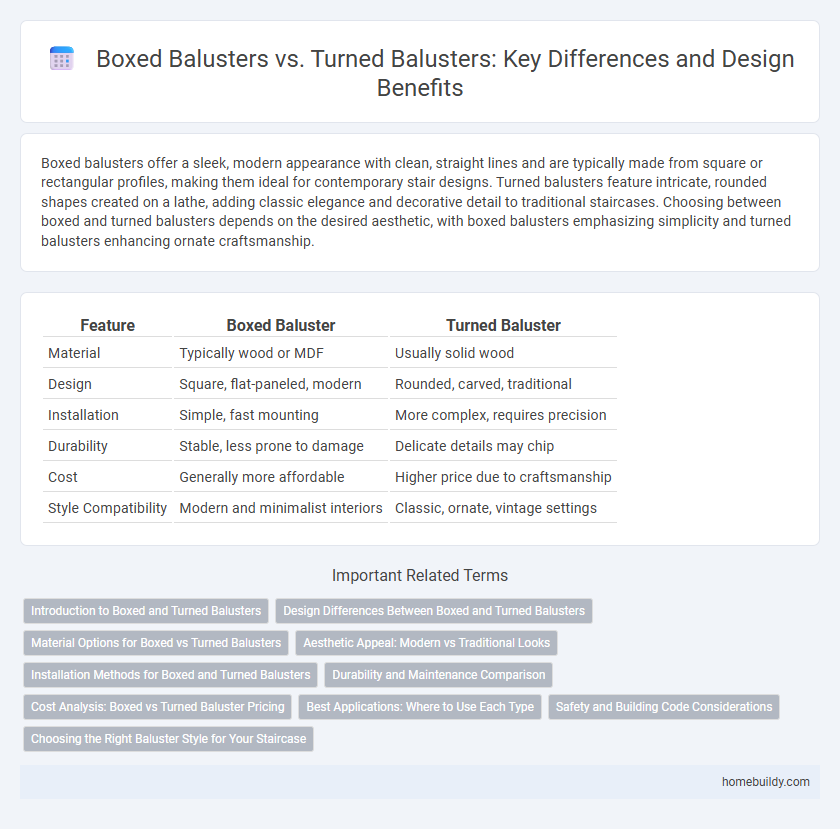Boxed balusters offer a sleek, modern appearance with clean, straight lines and are typically made from square or rectangular profiles, making them ideal for contemporary stair designs. Turned balusters feature intricate, rounded shapes created on a lathe, adding classic elegance and decorative detail to traditional staircases. Choosing between boxed and turned balusters depends on the desired aesthetic, with boxed balusters emphasizing simplicity and turned balusters enhancing ornate craftsmanship.
Table of Comparison
| Feature | Boxed Baluster | Turned Baluster |
|---|---|---|
| Material | Typically wood or MDF | Usually solid wood |
| Design | Square, flat-paneled, modern | Rounded, carved, traditional |
| Installation | Simple, fast mounting | More complex, requires precision |
| Durability | Stable, less prone to damage | Delicate details may chip |
| Cost | Generally more affordable | Higher price due to craftsmanship |
| Style Compatibility | Modern and minimalist interiors | Classic, ornate, vintage settings |
Introduction to Boxed and Turned Balusters
Boxed balusters feature a hollow, square or rectangular profile created from joined wood or metal panels, offering a clean, modern aesthetic with streamlined durability ideal for contemporary stairs. Turned balusters are crafted by spinning wood or metal on a lathe, producing intricate, rounded shapes that highlight traditional craftsmanship and add ornate detailing to staircases. Choosing between boxed and turned balusters depends on design preference, where boxed balusters emphasize simplicity and strength while turned balusters showcase classic elegance and detailed artistry.
Design Differences Between Boxed and Turned Balusters
Boxed balusters feature a sleek, geometric design characterized by straight lines and a hollow, square or rectangular profile, offering a modern, minimalist aesthetic ideal for contemporary staircases. Turned balusters are crafted on a lathe, creating intricate, rounded shapes with varying contours and decorative details, lending a traditional, elegant look often suited for classic or ornate stair designs. The choice between boxed and turned balusters significantly impacts the staircase's visual appeal by balancing simplicity and complexity, with boxed balusters emphasizing clean lines and turned balusters showcasing craftsmanship and decorative artistry.
Material Options for Boxed vs Turned Balusters
Boxed balusters are typically crafted from engineered wood, MDF, or metal, offering durability and a sleek, modern appearance ideal for contemporary stair designs. Turned balusters are commonly made from solid hardwoods like oak, maple, or cherry, providing intricate detailing and a classic, traditional look. The choice between boxed and turned balusters often depends on material preferences, with boxed options favoring versatile finishes and turned balusters showcasing natural wood grain and craftsmanship.
Aesthetic Appeal: Modern vs Traditional Looks
Boxed balusters provide a sleek, minimalist aesthetic that complements modern and contemporary staircase designs, offering clean lines and geometric shapes. Turned balusters feature intricate, rounded profiles created on a lathe, giving staircases a classic, traditional charm with detailed craftsmanship. The choice between boxed and turned balusters significantly influences the overall visual style, with boxed emphasizing simplicity and turned enhancing ornate elegance.
Installation Methods for Boxed and Turned Balusters
Boxed balusters typically feature a hollow construction, allowing for simpler installation by sliding over a wood core or directly securing to the stair stringer with screws, minimizing visible fasteners. Turned balusters, crafted from solid wood or metal, require precise drilling and mounting either through a top rail and skirt board, using tenons or pins for secure attachment. The boxed baluster installation process is generally faster and less labor-intensive, while turned balusters demand careful alignment and specialized hardware for a stable, aesthetically pleasing finish.
Durability and Maintenance Comparison
Boxed balusters, constructed from solid wood or composite materials, offer superior durability due to their sturdy, enclosed design that resists warping and damage over time. Turned balusters, typically made from softer woods and featuring intricate shapes, require more frequent maintenance such as sanding and repainting to preserve their detailed finishes. In terms of long-term upkeep, boxed balusters provide a low-maintenance solution ideal for high-traffic areas, whereas turned balusters demand regular attention to maintain their aesthetic appeal.
Cost Analysis: Boxed vs Turned Baluster Pricing
Boxed balusters generally cost less than turned balusters due to their simpler manufacturing process and use of flat wood or metal components. Turned balusters, crafted on a lathe with intricate designs, incur higher labor and material costs, increasing overall pricing by 20-40%. Homeowners aiming for budget-friendly stair enhancements often prefer boxed balusters, while those seeking ornamental appeal typically invest in the higher-priced turned options.
Best Applications: Where to Use Each Type
Boxed balusters with their clean, sturdy lines are ideal for modern and contemporary staircases, providing a minimalist look that complements open, spacious interiors and outdoor decks. Turned balusters, characterized by their decorative, rounded profiles and classical craftsmanship, are best suited for traditional or Victorian-style homes, adding intricate detail and elegance to interior staircases and grand entryways. Selecting boxed balusters enhances durability in high-traffic areas, while turned balusters elevate aesthetic appeal in formal spaces.
Safety and Building Code Considerations
Boxed balusters, typically constructed from solid wood or metal with a square profile, provide enhanced structural integrity and meet stringent building codes by offering consistent spacing to prevent accidental falls, especially important in residential and commercial staircases. Turned balusters, often intricately shaped and made from weaker materials like spindle wood, may require additional reinforcement to comply with safety regulations that mandate specific baluster spacing and strength to withstand significant lateral forces. Building code standards such as the International Residential Code (IRC) specify a maximum 4-inch gap between balusters, a criterion more easily maintained with the uniform design of boxed balusters, ensuring safer stair applications.
Choosing the Right Baluster Style for Your Staircase
Boxed balusters offer a sleek, modern look with clean lines and are typically made from wood or metal, providing durability and minimal maintenance. Turned balusters, crafted on a lathe, showcase intricate designs and traditional craftsmanship, adding elegance and detail to classic staircase styles. Selecting the right baluster style depends on the desired aesthetic, with boxed balusters complementing contemporary interiors and turned balusters enhancing traditional or ornate decor.
boxed baluster vs turned baluster Infographic

 homebuildy.com
homebuildy.com